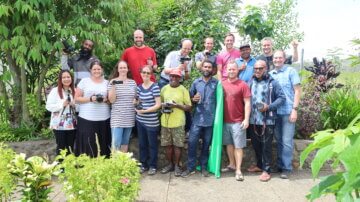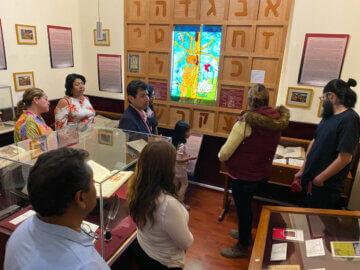Translation and Theology
Synopsis:
Throughout history, missionary activity has included use of the vernacular. Christian scriptures have been translated into over 2,400 of the world’s languages, often with accompanying dictionaries and grammars. This has aided cultural preservation, because it recognizes and accepts the significance of indigenous cultures and the worth of their languages.
Church historians acknowledge the contribution of Bible translation to the spread of the church. It started with Jerome’s Latin Vulgate, was strengthened through various European translations, impacted English culture through the King James Bible, and spread to other vernaculars in countries of the Pacific, Asia, Africa and South America.
The beginning of Wycliffe Bible Translators might be described as a ‘turning point’ of Christianity moving from the West to the global South and East, where traditional and world religions influence cultural value systems. Cross-cultural work needs to respond to such systems by providing contextually relevant meanings of the gospel so that its message may be clearly understood.
It is worth remembering that the church existed before any of the New Testament was written. There are accounts of churches that functioned for a long time without the written Bible because people did not have the literacy skills to access the translated text.
On the other hand, during times of persecution of the Church and heresy within the Church, those who have access to and understand the vernacular Bible are better equipped to remain resilient in their Christian faith than churches without scripture in local languages.
Because God does not place restrictions on how people interact with the Bible, some practices can lead to dangerous pitfalls and abuse, while others lead to positive transformation. Even when properly-contextualized translation is achieved, there is no assurance that the Bible will be used in the manner God intended.
Article: Article 6 – Translation and Theology
The use of translated Scripture enables theologizing
Throughout history missionary activity has included the use of the vernacular. The particular language was not a means to an end but, as Sanneh points out, was “endowed with divine significance, so that [it] may substitute completely for the language of revelation” (1993:142).
Christian missionary activity...recognizes and accepts the significance of indigenous cultures and the worth of their languages.
The Christian scriptures have been translated into over 2,400 languages spoken in the world today. Christian missionary activity has been “the impulse behind the creation of more dictionaries and grammars of the world’s languages than any other force in history” (Sanneh 2003:69). This activity has aided cultural preservation because it recognizes and accepts the significance of indigenous cultures and the worth of their languages. Sanneh points out that “mission seems to press to its logical conclusion the premise of the admissibility of all cultures in the general sweep of God’s ‘plan of salvation’” (1993:141).
Regional issues of contextualization and translation
The process of contextualization is important in the global South and East because their traditional and world religions influence cultural value systems. Missionary activity needs to respond to such systems by providing contextually relevant meanings of the gospel so that its message may be clearly understood. In Asia for example, the belief in demons, astrology, spirits, and local deities is part of the majority of traditional Asian worldviews. In such societies language and culture are intimately intertwined. In countries like Papua New Guinea and parts of Africa, translators also need to understand and interpret sorcery and witchcraft according to cultural beliefs.
The theological impact of Bible translation has had far reaching consequences in the development of African theologies in the last one hundred years. Bediako notes how this creates “a substratum of vital Christian consciousness and a sufficiently deep apprehension of Jesus Christ at the level of religious experience” (2004:58). African theology seriously “treats African mother-tongues as a fundamental medium in its theological discourse” (Bediako 2004:58). This is a testament to how the Bible and the Christian faith have impacted African life. Sanneh calls this an “indigenous discovery [that] places the emphasis on unintended local consequences, leaving the way open for indigenous agency and leadership” (2003:55). This can be observed in the African Initiated Churches (AIC) as well as the house churches in China. These are new forms of contextual expressions that the church has taken.
It is worth pausing to be reminded that the church existed before any of the New Testament was written.
It is worth pausing to be reminded that the church existed before any of the New Testament was written. There are accounts of churches that functioned for a long time without the written Bible because people did not have the literacy skills that would give them access to the translated text. There have also been Christians who for various reasons could not own any portion of translated scriptures. These situations serve as a reminder that “the Holy Spirit is not limited to situations where everyone has their own copy of the translated book” (Smalley 1991:217).
There is a well-documented situation of the post New Testament era North African church. It was a Latin language church amidst predominantly Berber languages. During the Muslim conquest of the seventh century, Christianity was wiped out amongst the Berber people. One reason this happened was because they were “without scriptures or significant biblical teaching in any of the North African vernaculars” (Smalley 1991:220). There was a lack of inculturation of the Christian faith amongst the Berber and thus they “lost all recollection of their Christian heritage” (Johnstone 2006:32). Bible translation was only started amongst the Berbers in the later part of the twentieth century.
However, the situation was different in Egypt and Ethiopia where the Bible was translated early on. Although the church was significantly weakened by the spread of Islam, it did not disappear because it had vernacular scriptures. Eventually many of the languages were outdated and with the growth of Arabic as the major language of the region the church began providing literature and scriptures in Arabic (Smalley 1991:220).
During times of persecution of the Church ..., those who have access to the vernacular Bible and understand it are better equipped to remain resilient in their Christian faith.
The growth of the Church in the global South and East has happened for a number of reasons. A particular example is how, during times of persecution of the Church and heresy within the Church, those who have access to the vernacular Bible and understand it are better equipped to remain resilient in their Christian faith. However, churches without scripture in local languages “even those at centres of Christianity like Alexandria, have disappeared from the map” (Hill 2006:82).
Attitudes towards the vernacular Bible
The beginning of Wycliffe Bible Translators might be described as a ‘turning point’ of Christianity moving from the West to the global South and East. Mark Noll wonders if Townsend’s founding of Wycliffe “may stand symbolically for one of the great Christian events of the age” (2004:310) because of the organization’s high profile promotion of Bible translation. He states that Bible translation therefore “may be the most enduringly significant feature of the global expansion of Christianity that has been taking place since the start of the nineteenth century” (Noll 2004:308).
Church historians acknowledge the contribution of Bible translation to the spread of the church. It started with Jerome’s Latin Vulgate, was strengthened through various European translations, impacted English culture through the King James Bible, and spread to other vernaculars in countries of the Pacific, Asia, Africa and South America.
How the Bible gets used
The use of the translated Bible can be portrayed in a number of ways. The applications vary and include some dangerous pitfalls and abuse, while others lead to positive transformation. Smalley suggests these eight possibilities:
- A cultural artefact of a foreign religion: The Scriptures may be used out of inquisitiveness to discover more about Jesus or Christianity. This can have a positive impact when the discovery leads to a commitment to follow Christ.
- A fetish book: The Bible can be used for magic or as a good luck charm for personal protection. In such cases the book is believed to be sacred in and of itself without reference to its contents. The “physical book itself performs its work by its presence” (Smalley 1991:225).
- A law book: This occurs when the laws of the Old Testament are used literally. Christians have of course attempted to follow the Ten Commandments. However, more significant are attempts to literally adhere to Old Testament laws about the Sabbath, clothing, tithing and prohibitions about veneration of ancestors, polygamy, etc. (Smalley 1991:226).
- A textbook: The Bible functions as a textbook often when school education is not available. It provides the primary source of information on items outside of one’s own experience and culture and gives “glimpses of other cultures, times and places” (Smalley 1991:227). For example, the Bible has also been a source book for finding names for children.
- A reference book: The addition of chapter and verse markings has enabled people to look up details of Bible narratives and teachings when they forget certain details, or want to share a story or passage with someone else.
- A behavioural manual: The Bible is used as a guidebook on individual morals, or on how to act in the church and worship God. “It may be used in a legalistic way (the Bible as law book), or more sensitively and contextually, by trying to understand from the Bible what present life and worship should be like in present-day circumstance” (Smalley 1991:228).
- A devotional-worship book: It is also a practice to use the Bible for individual devotional life, read or sung so that “people meditate on what they find in it, and use it as a stimulus to prayer, and to thank God” (Smalley 1991:230).
- As an oracle: The translated Bible is believed to be the actual eternal words of God. In such cases God is literally speaking Kewa, Korean or KiSwahili. It is also when people use the translated book “as a mirror in which they see themselves as they read” (Smalley 1991:231-2).
In considering each of these uses, we should remember that God does not place restrictions on how people interact with the Bible. There are a variety of practices although some are really abuses. On the other hand some uses have led to renewal and the transformation of individuals and their communities.
When engaging with contemporary culture the important factor, according to Alan Roxburgh and Fred Romanuk (2006:34) is a discovery in “how to indwell the Scriptures... with the narrative presence of God, who invites us into a story that reads and shapes us”.
Conclusion
Although properly contextualized translation is difficult to achieve, there are examples of where it has been done well. There are also examples of where it has not been achieved at all. Even when handled well, there is no assurance that the Bible will be used in the manner God intended. In fact, the Bible gets used in a variety of ways including those that are not helpful, such as a fetish, cultural artefact of a foreign religion, or a law book.
The latest
View all articles
03/2024 Pacific: Papua New Guinea
Informing, teaching, inspiring: PNG workshop teaches video storytelling for language communities
PNG workshop teaches video storytelling for language communities
Read more
02/2024 Global
Looking ahead at 2024
As the year unfolds, we marvel at the work of God in our rapidly changing world. And, we look forward to a number of gatherings and conversations intended to draw us together.
Read more
01/2024 Americas
Telling the Bible's Story
It may come as a surprise that a museum is among the Wycliffe Global Alliance organisations.
Read more